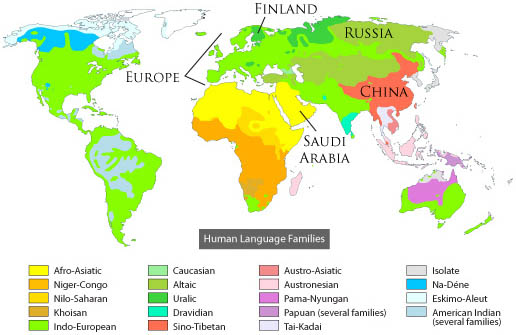|
Language is one of the most important cultural traits to
geographers. Languages make specific regions of the world
distinctive. One of the cultural traits that sets much of South
America apart from the rest of the world (except Spain) is the
widespread use of Spanish; however, in one country, Brazil, the
people speak Portuguese. This language difference sets Brazil apart
from the rest of South America.
The use of a different dialect also sets one area apart from
another. A dialect is a regional variety of a language; Australian
English and American English are two different dialects of the same
language. People who speak different dialects of the same language
can understand each other, but their pronunciation is different and
they use distinctive words. Even within the US there are different
dialects that are associated with particular regions. For example,
people from the southeastern states speak differently than people
from the northeastern states.
Over time, dialects can develop into completely different
languages. The thousands of languages spoken in the world today stem
from several main language families. Check out Figure 8.2.1 above.
The map shows the main language families used in each area of the
world. As you know, many languages are used in Europe, including
French, German, Spanish, Italian, and numerous others. Notice that
almost all of Europe speaks languages from the Indo-European
language family. The most notable exception to that is Finland. As
the map shows, the Finnish language is part of the same language
family that is found in northwest Russia. The arrangement of
languages gives us a basic idea of migration and settlement
patterns. The languages of North and South America are from the same
language family as those found in Europe. This same language family
can be found spread across parts of Asia as well as in Africa and
Australia. On the other hand, the Sino-Tibetan language family,
which is used by billions of people and includes Chinese, is limited
to the southeastern portion of Asia.
|





